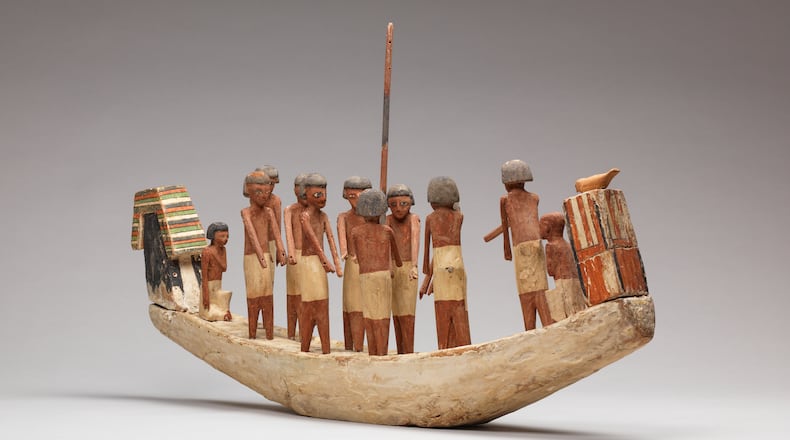This story was originally published by ArtsATL.
There are many reasons why the art of ancient Egypt is perennially fascinating to audiences, ranging from people’s love of hieroglyphs and mummies (which some museums are now referring to as “mummified persons”) to scholarly preoccupations. With “Life and the Afterlife: Ancient Egyptian Art from the Senusret Collection,” through Aug. 6, the Michael C. Carlos Museum has produced an exhibition that many different audiences should find delightful.
Credit: Bruce M. White
Credit: Bruce M. White
To address the scholarship question, quickly: These objects — approximately 165 of them — are drawn from the 1500-plus collection of art objects of the ancient world assembled by the late industrialist Georges Ricard, and donated to the museum by the Georges Ricard Foundation in 2018. Since then, the collection has been under intense analysis on every level by museum professionals.
This is the first thematic presentation based on a collection that also includes work from other parts of the ancient world, represented here in part by an exquisite Greek vase and a small funerary portrait from ancient Palmyra. The latter should please the lucky few who have seen enough examples of the art of this city between empires to fall in love with it. Otherwise, the show is about Egypt, with a strong focus on daily life in one village of skilled workers, Hetep-Senusret.
The show is full of visual stunners. The mummy case of Taosiris and the canopic chest of Dibastet exemplify the remarkable range of color and elegant imagery that gave birth to 20th-century designers’ so-called Egyptomania.
The little votive figures of gods that individuals donated to temples demonstrate an amazing range of delicate styles you wouldn’t necessarily expect in such humble, everyday expressions of religious devotion.
Credit: Courtesy of Michael C. Carlos Museum
Credit: Courtesy of Michael C. Carlos Museum
There are a surprising number of pieces associated with the components of ancient Egyptian history most museum visitors find most fascinating: the pharaoh Akhenaten’s turn to monotheism, and the reign of Tutankhamun after him. (These are in the form of inscriptions on stone tablets, but they’re here.)
In fact, there is a large fragment from the granite sarcophagus intended for the burial of Akhenaten’s wife Nefertiti, famous to contemporary audiences for the portrait bust of her, now in Berlin.
Credit: Bruce M. White
Credit: Bruce M. White
The inscription-rich stone is of such historical importance that it will be presented to Egypt’s ministry of antiquities after the exhibition ends, in recognition of the longstanding good relations between the Carlos and that institution.
(Atlantans will recall that the museum did the same 20 years ago when it discovered the mummy of the pharaoh Ramses I in a collection from a Niagara Falls museum.)
The objects themselves would be enough, but they’re also imaginatively displayed in a feat of exhibition design that highlights the exhibition’s thematic presentation of Egyptian daily life, religious life, and concern for the afterlife.
The transition into the gallery devoted to the afterlife features a short hallway, modified by Director of Exhibition Design Joseph Gargasz based on Melinda Hartwig’s suggestions. It is illuminated by a copy of the pattern of stars painted on the ceilings of Egyptian tombs and flanked by photographic images of the all-seeing eye that make for an aesthetically powerful rendering of what could otherwise have been a forgettable moment necessitated by a quirk in the Carlos’ two-building architectural history.
Last but assuredly not least, the show educates audiences in features of the everyday lives of ancient Egypt’s stonemasons and scribes and their families, without whose creative labors the works in this exhibition would never have existed. It’s amazing to see examples of the grinding palette and pestle with which scribes produced the inks they used to write hieroglyphs, and the palette that held the ground pigments and the reed pens.
There’s also the little stone tablet called a cippus, a depiction of the god Horus as a child controlling a dangerous animal. Families kept a cippus in their household to protect the family from animal bites.
Except when blockbuster exhibitions like this come along, it’s easy to reduce ancient Egypt to such visual shorthand as the Carlos’ unusually fine array of mummies, elegantly presented in their own segment of the permanent collection.
“Life and the Afterlife” is a wonderful way of refreshing our eyesight and our imagination with regard to this marvelous aspect of antiquity.
EXHIBIT REVIEW
“Life and the Afterlife: Ancient Egyptian Art from the Senusret Collection”
Through Aug. 6. $6-$8. Michael C. Carlos Museum, 571 S. Kilgo Circle, Atlanta carlos.emory.edu.
::
Jerry Cullum’s reviews and essays have appeared in Art Papers magazine, Raw Vision, Art in America, ARTnews, International Journal of African-American Art and many other popular and scholarly journals. In 2020 he was awarded the Rabkin Prize for his outstanding contribution to arts journalism.
MEET OUR PARTNER
ArtsATL (www.artsatl.org), is a nonprofit organization that plays a critical role in educating and informing audiences about metro Atlanta’s arts and culture. Founded in 2009, ArtsATL’s goal is to help build a sustainable arts community contributing to the economic and cultural health of the city.
If you have any questions about this partnership or others, please contact Senior Manager of Partnerships Nicole Williams at nicole.williams@ajc.com.
About the Author
Keep Reading
The Latest
Featured





